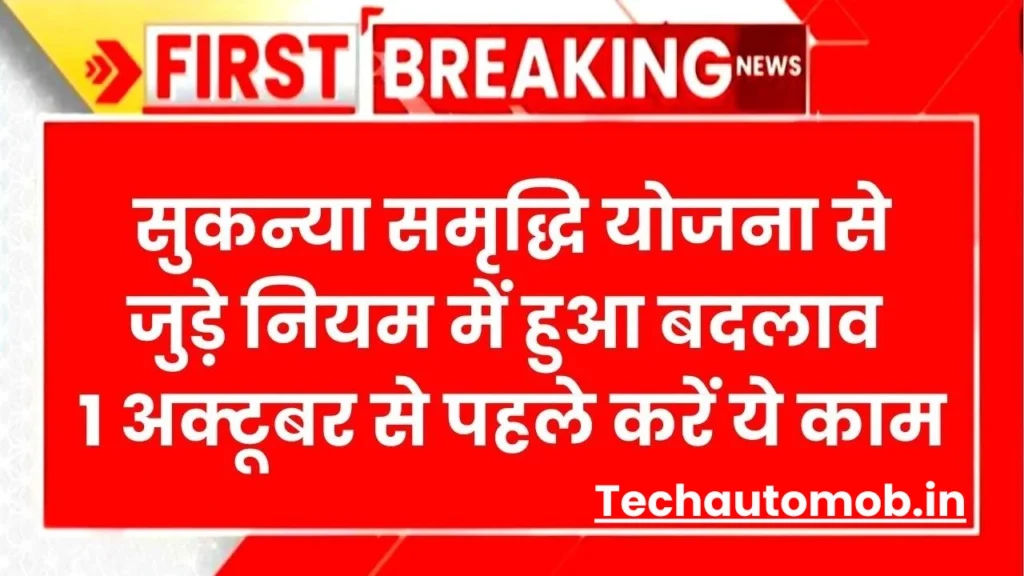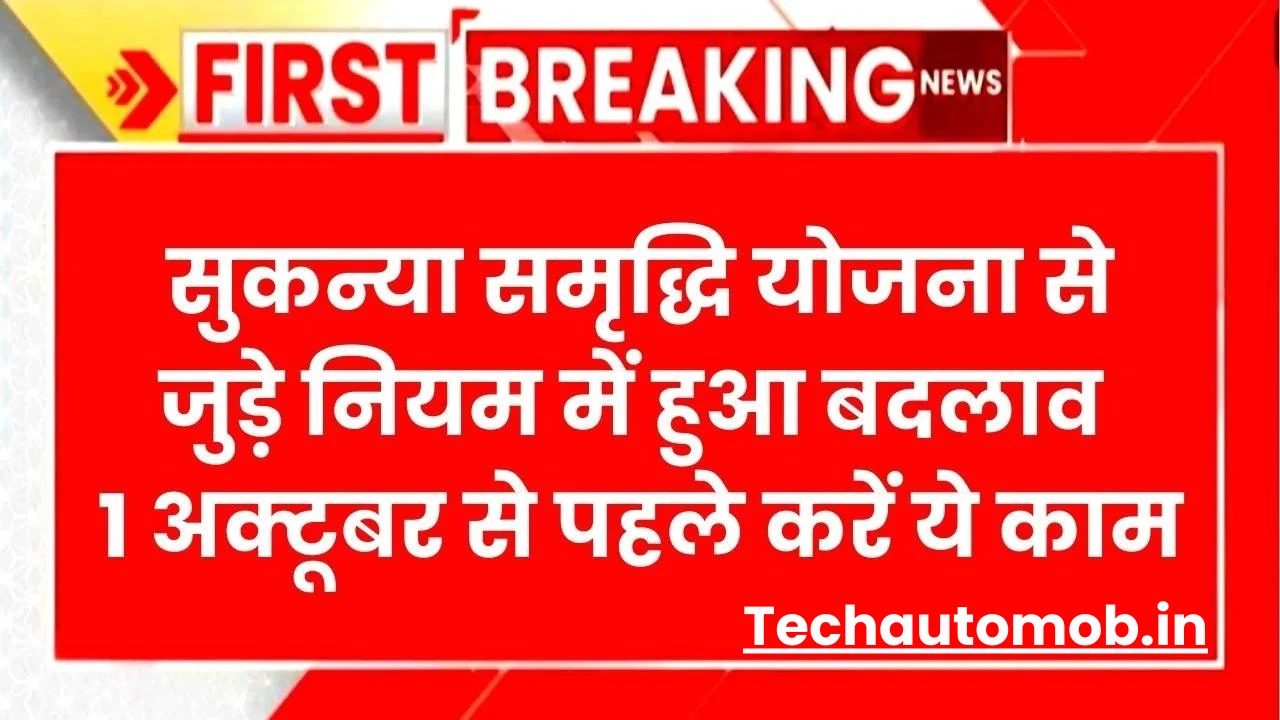Sukanya Samriddhi Yojana Rule Change:- The Sukanya Samriddhi Yojana (SSY) is a savings scheme initiated by the Government of India to secure the future of young girls, providing financial assistance for their education and marriage-related expenses. Launched on January 22, 2015, under the “Beti Bachao, Beti Padhao” campaign, the scheme aims to promote financial security for girls and support their families.
Table of Contents
Recent Rule Change: What You Need to Know
The Government of India has made a significant change in the Sukanya Samriddhi Yojana rules, effective from October 1, 2024. This change is crucial for families benefiting from the scheme, specifically addressing the legal guardianship required to open and operate accounts under SSY.
The New Rule: Only Legal Guardians Can Operate Accounts
From October 1, 2024, only legal guardians of the girl child are eligible to open and operate a Sukanya Samriddhi Yojana account. If the account was opened by someone other than the legal guardian, such as grandparents, uncles, or aunts, the account must be transferred to the legal guardian’s name. Failure to do so may result in the account being closed.
This change ensures that only the child’s natural parents or legal guardians will have control over the SSY account.

Documents Required for Account Transfer
To transfer the SSY account to the legal guardian’s name, you will need to visit the post office or bank where the account was initially opened. The following documents are required:
- Birth certificate of the girl child
- Identification proof of the parents or legal guardian (Aadhaar card, PAN card)
- Address proof of the guardian (ration card, voter ID, passport)
- Passport-size photo of the account opener
- Aadhaar card of the girl child (if available)
- Bank passbook or post office account details
- Sukanya Samriddhi account number and related documents
- Nominee details
- Proof of legal guardianship (if not the parents)
- Form-1 (account opening application form)
Once the necessary documents are submitted, the bank or post office will process the transfer request after verification, and the account records will be updated accordingly.
How to Open an SSY Account with ₹250
Opening an SSY account is simple and can be done at any authorized post office or bank branch. Here’s a step-by-step guide:
- Eligibility Check: The account can only be opened in the name of a girl child under 10 years of age. A family can open accounts for a maximum of two daughters (exceptions are made for twins).
- Prepare Documents:
- Birth certificate of the girl child
- Identification proof of the guardian (Aadhaar, PAN, voter ID)
- Address proof (ration card, electricity bill, etc.)
- Passport-size photos of both the child and guardian
- Aadhaar card of the girl child and guardian (if available)
- Visit the Bank/Post Office: Go to the nearest post office or bank and request the SSY account opening form. Fill out the form and submit the required documents.
- Minimum Deposit: To open the account, you need to deposit a minimum of ₹250. You can deposit a maximum of ₹1.5 lakh in a financial year.
- Bank/Post Office Procedure: After verifying the documents, the account will be opened, and you will be provided with a passbook that contains all the account details.
- Managing the Account: Regular deposits must be made. The account matures in 21 years, or earlier if the girl marries after turning 18. Partial withdrawals for higher education are allowed after the girl reaches 18.
Interest Rates for Sukanya Samriddhi Yojana (SSY)
The interest rate for Sukanya Samriddhi Yojana is determined by the government each quarter. Currently, for 2024, the interest rate is 8.2% per annum. This rate is quite attractive compared to other savings schemes, and interest is compounded annually until maturity.
SSY Maturity Period ( Sukanya Samriddhi Yojana Rule Change)
The maturity period for SSY accounts is 21 years from the date of account opening. Some key points regarding maturity are:
- Account Tenure: The account runs for 21 years or until the girl’s marriage after the age of 18.
- Deposit Period: Contributions must be made for the first 15 years, after which no further deposits are needed, but the account will continue to earn interest until maturity.
- Partial Withdrawal: After the girl turns 18, up to 50% of the amount can be withdrawn for her higher education or other significant expenses.
- Premature Closure: In special circumstances, such as serious illness or the untimely death of the account holder, the account can be closed after 5 years.
Maturity Amount
Upon maturity, the account holder receives the entire deposit amount along with the accrued interest, which is tax-free.
Purpose of Sukanya Samriddhi Yojana
The primary objective of SSY is to provide financial security for the education and future of girl children in India. Through this scheme, parents or guardians can save money for their daughter’s education, marriage, or other significant life events.
- Promoting Girl’s Education: The scheme encourages parents to save for their daughter’s higher education, ensuring that financial challenges do not hinder her academic progress.
- Financial Support for Marriage: SSY helps provide financial assistance for marriage expenses, ensuring parents have enough funds for such occasions.
- Securing the Future: SSY offers families a long-term, secure investment option to build a solid financial foundation for their daughters.
- Gender Equality: Launched under the “Beti Bachao, Beti Padhao” initiative, the scheme promotes gender equality by supporting the empowerment of girls in society.
Interest Calculation for SSY
Interest on SSY deposits is calculated on a compound interest basis, allowing the savings to grow significantly over time. The interest rates may vary, so it’s essential to keep an eye on government notifications.
Tax Benefits
Deposits made under the Sukanya Samriddhi Yojana are eligible for tax exemption under Section 80C of the Income Tax Act. Additionally, the interest earned and the maturity amount are also tax-free.
Key Takeaways:
- Eligibility: Girls under 10 years, with a maximum of two accounts per family.
- Minimum Deposit: ₹250; Maximum Deposit: ₹1.5 lakh per year.
- Interest Rate: 8.2% in 2024, compounded annually.
- Maturity Period: 21 years or earlier in case of marriage after 18.
- Tax-Free: Contributions, interest, and maturity amount are tax-exempt.
By making these changes, the government aims to provide enhanced security and benefits to girl children and their families under the Sukanya Samriddhi Yojana.
(FAQ) about Sukanya Samriddhi Yojana (SSY):
1. What is Sukanya Samriddhi Yojana (SSY)?
Sukanya Samriddhi Yojana is a government-backed savings scheme aimed at securing the financial future of girl children. It is part of the ‘Beti Bachao, Beti Padhao’ initiative, providing parents with an opportunity to save for their daughter’s education and marriage.
2. Who is eligible to open an SSY account?
Any parent or legal guardian can open an SSY account for a girl child who is under 10 years of age. Each family can open up to two accounts if they have two daughters. In case of twins or triplets, exceptions are allowed for more than two accounts.
3. Where can I open an SSY account?
You can open a Sukanya Samriddhi Yojana account at any authorized bank or post office across India.
4. What are the minimum and maximum deposit limits for SSY?
- Minimum Deposit: ₹250 per year.
- Maximum Deposit: ₹1.5 lakh per financial year.
5. What is the interest rate for SSY?
The interest rate for Sukanya Samriddhi Yojana is set by the government and revised every quarter. For 2024, the interest rate is 8.2% per annum. The interest is compounded annually.
6. What is the tenure of the Sukanya Samriddhi Yojana?
The SSY account matures 21 years from the date of opening or when the girl child gets married after turning 18. Contributions must be made for the first 15 years, but the account will continue to earn interest until maturity.
7. Can I make partial withdrawals from my SSY account?
Yes, once the girl reaches 18 years of age, up to 50% of the balance can be withdrawn for her higher education or other major expenses.
8. Can the SSY account be closed before maturity?
Yes, premature closure is allowed under specific circumstances, such as the untimely death of the account holder or life-threatening illness. Additionally, if the girl gets married after turning 18, the account can be closed.
9. Are there any tax benefits under SSY?
Yes, contributions made to Sukanya Samriddhi Yojana are eligible for tax deduction under Section 80C of the Income Tax Act. Moreover, the interest earned and the maturity amount are completely tax-free.
10. What documents are required to open an SSY account?
- Birth certificate of the girl child.
- Proof of identity of the parent or guardian (Aadhaar card, PAN card, etc.).
- Address proof of the guardian (Aadhaar, passport, voter ID, etc.).
- Passport-size photos of the child and guardian.
11. What happens if I miss a deposit?
If you miss a deposit, a penalty of ₹50 will be charged per year. You can reactivate the account by paying the penalty and making the minimum deposit for that year.
12. How is the maturity amount calculated?
The maturity amount consists of the total deposit plus the interest accrued over the period of the account, which is compounded annually. The amount is payable when the account reaches its maturity after 21 years or upon the girl’s marriage after 18 years.
13. What happens if the girl gets married before the account matures?
If the girl child gets married after turning 18, the SSY account can be closed, and the maturity amount can be withdrawn for her marriage or other purposes.
14. Can I transfer my SSY account to another bank or post office?
Yes, the SSY account can be transferred from one bank or post office to another if the account holder shifts to a new location. The transfer is free of charge.
15. Is there a limit on how much I can deposit in a financial year?
Yes, the maximum limit for deposits is ₹1.5 lakh per financial year.
16. Can both parents open an SSY account for the same girl child?
No, only one SSY account is allowed per girl child. Either parent or a legal guardian can open the account, but only one account per child is permitted.
17. Can I continue to deposit after 15 years?
No, you can only deposit money for the first 15 years from the date of account opening. After 15 years, the account will continue to earn interest until it matures at 21 years, but no further deposits are required.
18. How can I check the balance of my SSY account?
You can check your SSY account balance by updating your passbook at the bank or post office where the account was opened. Some banks also provide online access to view the balance.
19. What is the penalty for not maintaining the minimum deposit?
If the minimum deposit of ₹250 is not made in a financial year, the account will be considered inactive. A penalty of ₹50 per year must be paid to reactivate the account, along with the minimum deposit for the missed year(s).
20. Can I change the guardian on an SSY account?
Yes, in certain cases, such as the death of the original guardian or a legal change in guardianship, the account can be transferred to a new legal guardian.
21. What happens if the girl child passes away?
In the unfortunate event of the death of the girl child, the SSY account will be closed immediately. The deposit along with accrued interest will be paid to the legal guardian or parents of the child.
22. Is it mandatory to submit proof of the girl child’s education to withdraw funds for education purposes?
Yes, to make partial withdrawals for education purposes after the girl turns 18, you must provide proof of admission to a recognized educational institution.



